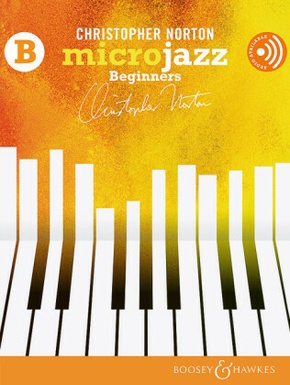
| Verlag | Schott Music |
| Auflage | 2023 |
| Seiten | 36 |
| Format | 22,9 x 0,4 x 30,3 cm |
| 2 Noten mit Online-Audiodateien (Rückendrahtheftung) | |
| Gewicht | 164 g |
| Reihe | Microjazz |
| ISBN-13 | 9781784546793 |
| Bestell-Nr | 78454679UA |
Christopher Nortons hochgelobte Reihe Microjazz ist durch den spannenden Mix aus zeitgenössischen Genres und klassischer Tradition bei Lehrenden und Lernenden auf der ganzen Welt beliebt. Zwei Hefte für Anfänger und fünf Bände mit Repertoirestücken entsprechen sieben klar definierten Leistungsniveaus, die Microjazz zur idealen Grundlage für aufeinander aufbauendes Lernen und Lehren machen.Microjazz Beginners ist der zweite Band der Serie und eignet sich für Lernende jeden Alters. Mit einer Kombination aus Erklärungen, Musikstücken und Illustrationen werden die Schüler:imnnen zuverlässig bei den ersten Schritten sowohl in den praktischen wie den theoretischen Aspekten des Klavierspiel begleitet.Die eingelegte Klavierbegleitung eignet sich für Lehrende oder Spieler:innen der Mittelstufe. Die so entstehenden Duette können auf einem oder zwei Klavieren gespielt werden und verwandeln auch die einfachste Melodie in ein unverwechselbares Microjazz-Stück.Online verfügbares Audiomaterial m it vollständigen Beispieltiteln sowie einzelnen Begleit-Playbacks tragen zur Begeisterung und Verbesserung beim Üben und für Aufführungen bei. Schwierigkeitsgrad: 1-2
Inhaltsverzeichnis:
Chapter 1In this chapter you will learn how to:- build and play major scales- read and play music written within key signaturesIntroduction - A new piece - Left behind - Building a major scale - Walkung tune - Key signatures - Swap over - Delicate touchChapter 2In this chapter you will learn how to:- read, play and follow rhythms which include quavers- play using a new hand position for the left hand, with new notes (C and D)- play two-note chords in the left hand- recognise and describe intervals using numbersQuavers - Step time - A waltz tune - Buttercups - Standing alone - A new rhythm - Jumpy - Calm waters - A new position for your left hand - Cathedral Close - Echoes - Chords - Folk tune - A little raggy - Intervals Chapter 3In this chapter you will learn how to:- play using a new hand position for the right hand, with new notes (A, B, C and D)- play using a new hand position for the right hand, including a new note (B flat)- play music in a 'blues' style- understand ledger l ines- play using a new hand position for the right hand, with a new note (G)A new position for your right hand - Climbing - Snowdrop waltz - Going somewhere - More new positions for your right hand - Two can play - Got the blues - In a flap - Ledger lines - Hymn tune - Mule trainChapter 4In this chapter you will learn how to:- play using a new hand position for the left hand, with new notes (G, A and B)- construct and play two-note chords in the right hand- adopt good fingering technique to play scales smoothly- move your hand position during a pieceA new position for your left hand - Slow lane - Never catching up - More about chords - Bus lane - Step up - Playing scales - Ledger line scales - Moving your hand - Finger swapping - Fancy that Chapter 5In this chapter you will learn how to:- understand, clap and play rhythms which include dotted notes- build and play minor scales- play using a new hand position for the right hand, with very high notes- recognise and understand quaver restsDotted notes - On the dot - Two-timing - Oboe tune - Scale of E minor - Last chance - A new scale to play - Ups and downs - A new position for your right hand - All change! - Quaver rests - Rock steady - Scale of F major - Into the sun Notes
